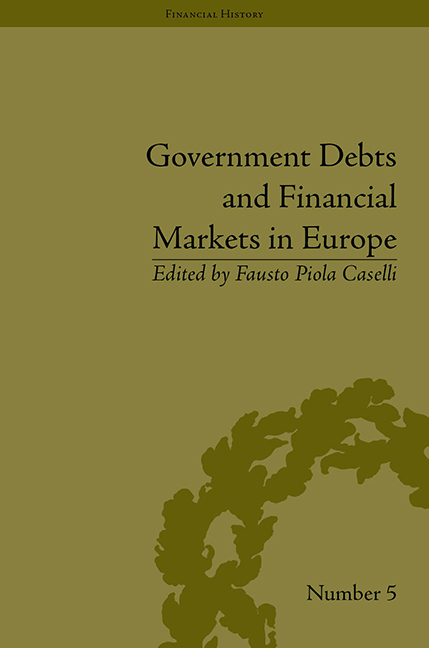Book contents
- Frontmatter
- CONTENTS
- Contributors
- List of Charts and Tables
- Introduction
- 1 The Financial Administration of North Hanseatic Cities in the Late Middle Ages: Development, Organization and Politics
- 2 Government Debts and Credit Markets in Renaissance Italy
- 3 Government Debts and Financial Markets in Castile between the Fifteenth and Sixteenth Centuries
- 4 Government Debt and Financial Markets: Exploring Pro-Cycle Effects in Northern Italy during the Sixteenth and the Seventeenth Centuries
- 5 Government Policies and the Development of Financial Markets: The Case of Madrid in the Seventeenth Century
- 6 The Role Played by Short-Term Credit in the Spanish Monarchy's Finances
- 7 From Subordination to Autonomy: Public Debt Policies and the Creation of a Self-Ruled Financial Market in the Kingdom of Naples in the Long Run (1500–1800)
- 8 Public Debt in the Papal States: Financial Market and Government Strategies in the Long Run (Seventeenth–Nineteenth Centuries)
- 9 Towards a New Public Credit Policy in Eighteenth-Century Spain: the Introduction of the Tesorería Mayor de Guerra (1703–6)
- 10 French Public Finance between 1683 and 1726
- 11 Long-Term War Loans and Market Expectations in England, 1743–50
- 12 Mercantilist Institutions for the Pursuit of Power with Profit: The Management of Britain's National Debt, 1756–1815
- 13 Italian Government Debt Sustainability in the Long Run, 1861–2000
- 14 Times of Wasteful Abundance: The Apogee of the Fiscal State in the Federal Republic of Germany from the 1960s to the 1980s
- Conclusion: Final Remarks
- Notes
- Bibliography
- Index
8 - Public Debt in the Papal States: Financial Market and Government Strategies in the Long Run (Seventeenth–Nineteenth Centuries)
- Frontmatter
- CONTENTS
- Contributors
- List of Charts and Tables
- Introduction
- 1 The Financial Administration of North Hanseatic Cities in the Late Middle Ages: Development, Organization and Politics
- 2 Government Debts and Credit Markets in Renaissance Italy
- 3 Government Debts and Financial Markets in Castile between the Fifteenth and Sixteenth Centuries
- 4 Government Debt and Financial Markets: Exploring Pro-Cycle Effects in Northern Italy during the Sixteenth and the Seventeenth Centuries
- 5 Government Policies and the Development of Financial Markets: The Case of Madrid in the Seventeenth Century
- 6 The Role Played by Short-Term Credit in the Spanish Monarchy's Finances
- 7 From Subordination to Autonomy: Public Debt Policies and the Creation of a Self-Ruled Financial Market in the Kingdom of Naples in the Long Run (1500–1800)
- 8 Public Debt in the Papal States: Financial Market and Government Strategies in the Long Run (Seventeenth–Nineteenth Centuries)
- 9 Towards a New Public Credit Policy in Eighteenth-Century Spain: the Introduction of the Tesorería Mayor de Guerra (1703–6)
- 10 French Public Finance between 1683 and 1726
- 11 Long-Term War Loans and Market Expectations in England, 1743–50
- 12 Mercantilist Institutions for the Pursuit of Power with Profit: The Management of Britain's National Debt, 1756–1815
- 13 Italian Government Debt Sustainability in the Long Run, 1861–2000
- 14 Times of Wasteful Abundance: The Apogee of the Fiscal State in the Federal Republic of Germany from the 1960s to the 1980s
- Conclusion: Final Remarks
- Notes
- Bibliography
- Index
Summary
Origin and Growth of Papal Debt
Regular public debt in the Papal States lagged far behind the main Italian city states. Except the well-known venality of offices, it started officially in 1526 with the first issue at a 10 per cent yearly rate (Monte Fede) and expanded markedly only after the second half of the sixteenth century.
Papal debt increased at a rapid pace throughout the seventeenth century until the large 1684 and 1687 concentrations of a jumble of different issues into the St Peter Monti, reduced at 3 per cent. In little more than a century and a half the Camera Apostolica – the central treasury – had authorized 187 separate issues: 71 to provide funds to the treasury itself; 55 to bail out the Roman nobility; 23 to benefit the Capital city; and 38 to underwrite the debts the communities had accumulated with the Apostolic Chamber.
After the end of the seventeenth century nearly all new emissions were issued to replace older ones, at the nominal value of 100 silver scudi for each luogo, or bond. The total stock of debt stabilized around 50 million scudi. Interest rates remained stable at 3 per cent, but bonds were always highly appreciated in the secondary market, fetching prices well above par until the end of the eighteenth century, when the Napoleonic Wars shattered the whole system.
From the available documentation, Chart 8.1 shows the debt growth (interest paid on yearly balance sheet expenditures from 1599) for two hundred years.
The two logarithmic curves apparently show a continuous increase, with a clear parallelism between expenditures and interests paid. However, nominal values in the long run do not describe correctly the real dimension of public debt. From a demographic point of view, the Papal State population gained a good 25 per cent from the late sixteenth to late eighteenth century, mainly due to the annexation of the Ferrara territories (1598) and the conquest of the Farnese Castro duchy (1649).
- Type
- Chapter
- Information
- Government Debts and Financial Markets in Europe , pp. 105 - 120Publisher: Pickering & ChattoFirst published in: 2014



